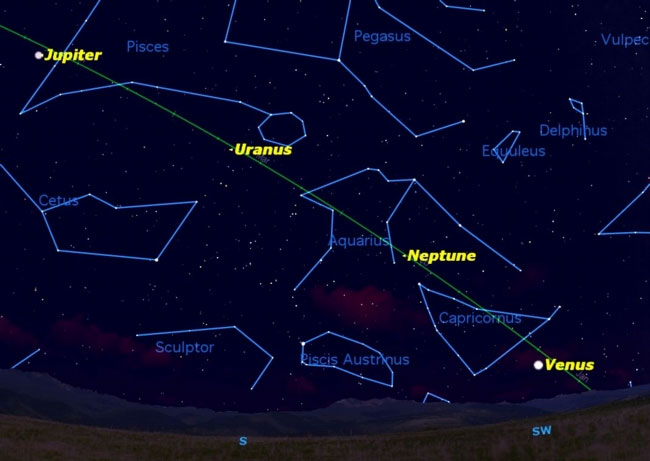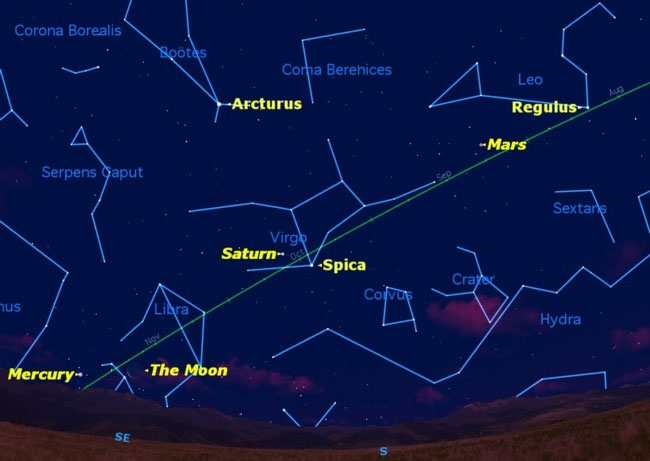Interesting spectacle of 7 planets showing up
5 am on December 22 (VN time), a very rare spectacle of the universe has taken place: Venus and Jupiter glow in the sky, while Neptune and Neptune star in the sky. middle and visible with small telescopes.
According to Space.com , this is a rare opportunity for astronomers to observe all the major planets of the solar system on the same night. The diagonal that cuts across the sky created by the four planets is called a rectangular / eclipse, because it is also the line that the moon, the sun and the Earth need to create when there is eclipse / eclipse.

Four planets of Venus, Jupiter, Neptune and Thien Vuong stars
together form a diagonal across the sky (space.com)
However, the excitement hasn't stopped there. By about 6pm this afternoon (Vietnam time), people in some areas of the world will be able to observe the remaining three large planets. At this time, the Japanese road / lunar eclipse was tilted in the opposite direction and along it, one could see Mercury, moon, Saturn and Mars. Far away, in the 'background' part will be three of the brightest stars : Arcturus (also known as Alpha Bootes and 'bear keeper' ), Regulus (the brightest star in Leo's star cluster) and Spica ( The brightest star in the Virgo cluster. In particular, why Spica received special attention, because in 2012, the moon will have many opportunities to fly close to Spica, even when it will fly to cut the face of this star. The approach at close distance between two such space objects is called association . Although their meaning is not so important to modern astronomy, it is always very interesting phenomena to observe.

By 6pm this afternoon, the planets and the remaining stars will turn out to be in turn.
Even so, the planets and queues of the planets today are completely contrary to the association. No planet is near each other. The most special feature of the main event is that 7 planets are distributed around the eclipse line very evenly. The only two planets that lie slightly apart are Mars and Jupiter, Space said.
- Unknown mystery about planets outside the solar system
- Discover more 18 large planets
- 'Star' also plays basketball
- Why are planets spherical, and meteorites?
- 8 planets are not true to haunt the scientific world
- Discover more than 700 planets outside the solar system
- Planets in the Solar System
- Dead planets may be signaling in outer space
- Why the dead planet?
- Detecting the outer three planets about the size of the Earth
- Interesting: The waterfall has water ... flowing up and down the sky
- There are at least 50 billion planets in the Milky Way
 Van Allen's belt and evidence that the Apollo 11 mission to the Moon was myth
Van Allen's belt and evidence that the Apollo 11 mission to the Moon was myth The levels of civilization in the universe (Kardashev scale)
The levels of civilization in the universe (Kardashev scale) Today Mars, the sun and the Earth are aligned
Today Mars, the sun and the Earth are aligned The Amazon owner announced a secret plan to build a space base for thousands of people
The Amazon owner announced a secret plan to build a space base for thousands of people